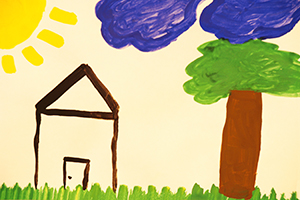
Art therapists are mental health professionals who guide clients through spontaneous art from the unconscious.
by Lucia Capacchione, Ph.D. —
Do you ever doodle while talking on the phone? Scribble on your class notes? Embellish the handouts at a business meeting with decorative designs?
Doodling seems to come naturally to most people and we do not think too much about it. Yet, there is more than meets the eye in these spontaneous drawings and designs. In fact, there is a treasure trove of meaning and therapeutic uses for drawings that seem to “happen” on their own. This is the domain of art therapy.
Art therapists are mental health professionals who guide clients through spontaneous art from the unconscious. Through drawing, painting, sculpting, collage and other modalities, art therapists provide tools for emotional expression and self-awareness.
Like dreaming on paper, the art created by clients in therapy sessions is often primitive, unschooled and perhaps even surreal. It requires no special talent, training or skill. This is not art for art’s sake, but rather, art for the client’s sake. It’s about the process, not the product or performance.
Art therapy often is used as a diagnostic tool for assessing what really is happening deep within. It is difficult to deceive ourselves with spontaneous art; often the truth comes out more readily than through words. Drawing from the unconscious, clients learn to understand and speak the language of symbols, the soul’s native tongue. Topics commonly explored include feelings, relationships, body image, career and more.
In a therapy session, art is created. The client is then guided to find meanings in the art through free-association. The process is a lot like interpreting dreams and, in fact, drawing or painting one’s nocturnal dreams is often included in art therapy sessions.
In one diagnostic session, a woman’s drawing showed explosions of color bursting out of a bottle from which a cork had been removed. She realized that the feelings she had literally “bottled up” for years were causing stress disorders in her body and tension in her relationships. In subsequent treatments, she learned how to release her feelings through a variety of art materials.
Like the bottle blowing its cork, many images in art therapy are literal illustrations of common phrases we use all the time to describe our mental and emotional states. Imagine a simple cartoon labeled, “I blew my top,” or “I feel scattered.”
Sometimes, a client might start the session describing his or her life with a phrase and then create a picture that portrays it. It might also be the other way around. A picture or abstract scribble is created that portrays a feeling or a life situation, and then a title emerges.
Art therapy also benefits clients dealing with physical health challenges or relationship conflicts. Releasing pent-up emotions through color, line and shape is certainly preferable to gunnysacking emotions in the body, where they turn into tension and pain.
Having a temper tantrum with crayons, torn paper collage or clay is a lot safer and more therapeutic than blowing up at a loved one or coworker. Instead of dumping on others, scribbling with kindergarten crayons and pounding clay are great ways to dump strong feelings.
Art therapists also use words. They encourage the client to let the pictures speak. A therapist might ask, “What would that red blob say if it could talk?” Or, “Have a conversation with the house in your picture.”
As the feeling self is embraced, a huge burst of creativity often emerges, as well. Not that clients necessarily become artists; that is not the goal. However, many art therapy patients report they have become far more creative in their lives. Or they take up hobbies and pastimes that allow for some kind of creative expression.
Perhaps one of the most powerful outcomes of art therapy is creating images of inner wisdom figures, who provide comfort and guidance in choices and life transitions. Through art-making, dreams and visions of a possible future, the creation of spontaneous art from the heart can guide and heal all areas of one’s life.
No talent or art training is necessary — only the desire to discover the voice of inner wisdom and creativity.
Lucia Capacchione, Ph.D., A.T.R., R.E.A.T., is a registered art therapist, international workshop leader, trainer and best-selling author of 13 books, including Recovery of Your Inner Child, The Creative Journal, Visioning and The Art of Emotional Healing. She is director of the Creative Journal Expressive Arts certification-training program. www.luciac.com.
Reprinted from AzNetNews, Volume 24, Number 4, August/September 2005.





October 13, 2013
Creativity, Emotional Wellness and Well-being, Healing, Health Concerns, Relationships